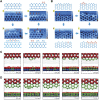Advances in Atomic Force Microscopy: Imaging of Two- and Three-Dimensional Interfacial Water
- PMID: 34631666
- PMCID: PMC8493245
- DOI: 10.3389/fchem.2021.745446
Advances in Atomic Force Microscopy: Imaging of Two- and Three-Dimensional Interfacial Water
Abstract
Interfacial water is closely related to many core scientific and technological issues, covering a broad range of fields, such as material science, geochemistry, electrochemistry and biology. The understanding of the structure and dynamics of interfacial water is the basis of dealing with a series of issues in science and technology. In recent years, atomic force microscopy (AFM) with ultrahigh resolution has become a very powerful option for the understanding of the complex structural and dynamic properties of interfacial water on solid surfaces. In this perspective, we provide an overview of the application of AFM in the study of two dimensional (2D) or three dimensional (3D) interfacial water, and present the prospect and challenges of the AFM-related techniques in experiments and simulations, in order to gain a better understanding of the physicochemical properties of interfacial water.
Keywords: atomic force microscopy; interfacial water; liquid/solid interface; machine learning; structure and dynamics.
Copyright © 2021 Cao, Song, Tang and Xu.
Conflict of interest statement
The authors declare that the research was conducted in the absence of any commercial or financial relationships that could be construed as a potential conflict of interest. The reviewer (RM) declared a past co-authorship with the authors (DC, LX) to the handling Editor.
Figures


Similar articles
-
Machine learning-aided atomic structure identification of interfacial ionic hydrates from AFM images.Natl Sci Rev. 2022 Dec 14;10(7):nwac282. doi: 10.1093/nsr/nwac282. eCollection 2023 Jul. Natl Sci Rev. 2022. PMID: 37266561 Free PMC article.
-
Advances in Atomic Force Microscopy: Weakly Perturbative Imaging of the Interfacial Water.Front Chem. 2019 Sep 12;7:626. doi: 10.3389/fchem.2019.00626. eCollection 2019. Front Chem. 2019. PMID: 31572715 Free PMC article.
-
Atomic- and Molecular-Resolution Mapping of Solid-Liquid Interfaces by 3D Atomic Force Microscopy.ACS Nano. 2018 Dec 26;12(12):11785-11797. doi: 10.1021/acsnano.8b07216. Epub 2018 Nov 13. ACS Nano. 2018. PMID: 30422619
-
Water distribution at solid/liquid interfaces visualized by frequency modulation atomic force microscopy.Sci Technol Adv Mater. 2010 Sep 8;11(3):033003. doi: 10.1088/1468-6996/11/3/033003. eCollection 2010 Jun. Sci Technol Adv Mater. 2010. PMID: 27877337 Free PMC article. Review.
-
Interfacial Liquid Water on Graphite, Graphene, and 2D Materials.ACS Nano. 2023 Jan 10;17(1):51-69. doi: 10.1021/acsnano.2c10215. Epub 2022 Dec 12. ACS Nano. 2023. PMID: 36507725 Free PMC article. Review.
Cited by
-
Machine learning-aided atomic structure identification of interfacial ionic hydrates from AFM images.Natl Sci Rev. 2022 Dec 14;10(7):nwac282. doi: 10.1093/nsr/nwac282. eCollection 2023 Jul. Natl Sci Rev. 2022. PMID: 37266561 Free PMC article.
References
-
- Abe M., Sugimoto Y., Namikawa T., Morita K., Oyabu N., Morita S. (2007). Drift-compensated Data Acquisition Performed at Room Temperature with Frequency Modulation Atomic Force Microscopy. Appl. Phys. Lett. 90 (20), 203103. 10.1063/1.2739410 - DOI
-
- Ardizzone S., Formaro L., Lyklema J. (1982). Adsorption from Mixtures Containing Mono- and Bivalent Cations on Insoluble Oxides and a Revision of the Interpretation of Points of Zero Charge Obtained by Titration. J. Electroanalytical Chem. Interfacial Electrochemistry 133 (1), 147–156. 10.1016/0022-0728(82)87013-7 - DOI
LinkOut - more resources
Full Text Sources
Miscellaneous

